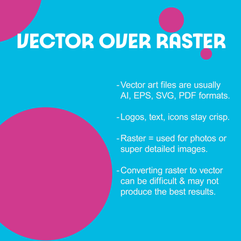Why Vector Art Works The Best For Screen Printing
- Tyler Vingino
- Oct 4
- 2 min read
Updated: Oct 19
When it comes to screen printing, the quality of your artwork file makes all the difference. While you may be tempted to send a quick JPEG or screenshot, the truth is that vector art works the best for screen printing.
From ensuring clean color separations to maintaining crisp detail at any size, vector files are the industry standard for professional results. Let’s break down why.
What is Vector Art?
Vector art is created using software like Adobe Illustrator or CorelDRAW. Unlike pixel-based images (raster graphics like JPEGs or PNGs), vector art is made from mathematical lines and shapes.
This means you can scale a design from the size of a business card to a billboard without losing any detail or sharpness.
The Problem with Low Resolution Images
Many first-time customers send screen printers files that look fine on a phone but aren’t suitable for production. Here’s why:
If the art file is low resolution, it’s difficult to separate colors and get it ready for printing.
Raster images are measured in DPI (dots per inch). For print, 300 DPI is considered “high resolution.”
Anything lower can look blurry, pixelated, or jagged once enlarged for t-shirt printing.
In other words, a file that looks okay online may not translate well to a print shop.
Why Vector Art is Needed for Screen Printing
Here’s why vector art is the gold standard:
Clean Color Separations
Screen printing requires each color to be isolated and printed on its own screen. Vector art is needed to separate colors accurately, ensuring sharp edges and no fuzzy overlaps.
Infinite Scalability
Need the design on a chest print and a full back print? No problem. Vector art scales perfectly without losing resolution.
Crisp Lines and Shapes
Text, logos, and fine details all stay sharp. With raster images, these can blur or distort.
Faster Setup in Production
Printers can prepare screens more efficiently when the artwork is already in vector format. This saves time and reduces the risk of errors.
Vector Art vs Raster Images (JPEG/PNG)
Feature | Vector Art | Raster Image |
Resolution | Infinite scalability | Limited by DPI (needs 300 dpi for print) |
File Types | AI, EPS, SVG, PDF | JPG, PNG, GIF |
Best For | Screen printing, logos, text | Photos, web images |
Color Separation | Easy & precise | Difficult & blurry |
When to Use Raster Images
Raster files aren’t always bad. Photographs or detailed full-color images are raster by nature. But for screen printing, they require high-resolution (300 DPI) files and sometimes extra work to prepare for color separation.
That’s why for most logos, text, and graphics, vector art is the most reliable option.
FAQs About Artwork for Screen Printing
Can I just send a screenshot of my logo?
Not recommended — screenshots are low resolution and can’t be scaled for print.
Is 300 DPI always good enough?
300 DPI is the minimum for raster images, but vector art is always preferred because it’s resolution-independent.
What file formats do screen printers prefer?
AI, EPS, or PDF (vector files) are the best. High-resolution TIFF or PSD files can work too, but may need extra preparation.
Can a raster logo be converted to vector?
Yes — but it usually requires manual tracing or redrawing to ensure accuracy.











Comments